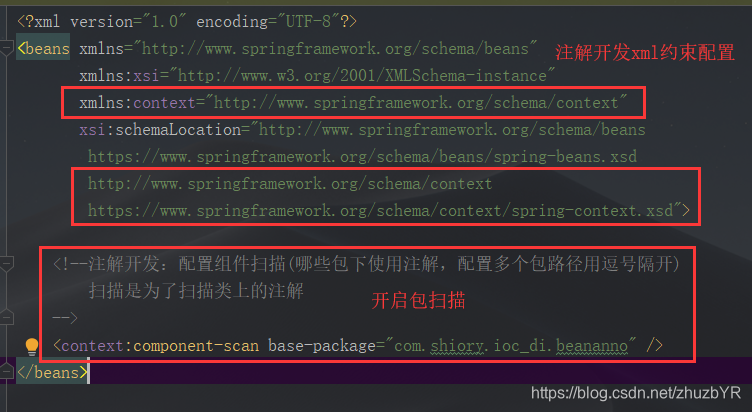1、maven依赖
<dependencies>
<!-- Spring上下文依赖 -->
<dependency>
<groupId>org.springframework</groupId>
<artifactId>spring-context</artifactId>
<version>5.1.9.RELEASE</version>
</dependency>
<!-- junit测试依赖 -->
<dependency>
<groupId>junit</groupId>
<artifactId>junit</artifactId>
<version>4.13-beta-3</version>
<scope>test</scope>
</dependency>
</dependencies>2、XML配置
<?xml version="1.0" encoding="UTF-8"?>
<beans xmlns="http://www.springframework.org/schema/beans"
xmlns:xsi="http://www.w3.org/2001/XMLSchema-instance"
xmlns:context="http://www.springframework.org/schema/context"
xsi:schemaLocation="http://www.springframework.org/schema/beans
https://www.springframework.org/schema/beans/spring-beans.xsd
http://www.springframework.org/schema/context
https://www.springframework.org/schema/context/spring-context.xsd">
<!--注解开发:配置组件扫描(哪些包下使用注解,配置多个包路径用逗号隔开)
扫描是为了扫描类上的注解
-->
<context:component-scan base-package="com.shiory.ioc_di.beananno" />
</beans>注解开发配置文件注意事项:
- 注解开发xml约束配置
- 开启包扫描

3、注解的使用
1、注解详解
/**
* Spring的Bean注解详解
* 使用注解的前提:在配置文件中配置了包扫描
* @Component("名称") : 组件
* 修饰一个类,将这个类交给Spring管理。
* 该注解有三个衍生注解(功能类似):
* @Repository("名称") : Dao层的类使用
* @Service("名称") : Service层的类使用
* @Controller("名称"): Web层的类使用
*
* 属性注入的注解
* 属性如果有Setter方法,需要将属性注入的注解添加到Setter方法上
* 属性如果没有Setter方法,需要将属性注入的注解添加到属性上
*
* 普通类型属性注解
* @Value("具体的值") :设置普通类型属性的值
* 对象类型属性注解
* @Autowired :设置对象类型属性的值。但是它是按照类型来完成属性的注入,跟名称没有关系
* 例:即使@Repository("personDao")改成了@Repository("personDao1111"), @Autowired也能完成注入
* 开发习惯是按照名称来完成属性的注入
* 那就必须让 @Autowired这个注解和@Qualifier("Dao层的名称")一起使用来完成按照名称属性注入
* @Resource(name = "Dao层的名称") :完成对象类型的属性注入,按照名称完成属性注入
* 实际开发中使用该注解来替换:@Autowired和@Qualifier配合使用
* 该注解不是Spring本身提供,而是Spring实现的一套规范提供:javax.annotation.Resource
*
* Bean的其他注解
* 生命周期相关注解:
* @PostConstruct :初始化,修饰一个方法
* @PreDestroy :销毁,修饰一个方法
* Bean的作用域注解
* @Scope : 作用域。,修饰一个类
* 取值:
* singleton :单例,默认取值
* prototype :多例
* request :应用在web项目中,Spring创建这个类以后,将这个类存入到request范围中
* session :应用在web项目中,Spring创建这个类以后,将这个类存入到session范围中
* globalsession :应用在web项目中,必须在porlet环境(有子网站)下使用。但是如果没有这种环境,相当于session
*/2、使用举例
Dao层
public interface PersonDao {
public void addPersion(String str);
}@Repository("personDao")
public class PersonDaoImpl implements PersonDao{
@Override
public void addPersion(String str) {
System.out.println("PersonDao.addPersion()被调用了。。。" + str);
}
}Service层
public interface PersonService {
public void addPerson();
}//@Component("personService")
@Service("personService")
//相当于在XML文件中写了:<bean id="personService" class="com.shiory.ioc_di.beananno.PersonServiceImpl" ></bean>
//@Scope("prototype")
//相当于:<bena id="" class="" scope="prototype" ></bean>
public class PersonServiceImpl implements PersonService{
// 普通类型属性注入
@Value("普通类型属性注入")
private String str;
// 对象类型属性注入
/*@Autowired
@Qualifier("personDao")*/
@Resource(name = "personDao")
private PersonDao personDao;
@Override
public void addPerson() {
personDao.addPersion(str);
}
// 下面两个方法的注解相当于:<bena id="" class="" init-method="init" destroy-method="destroy" ></bean>
/**
* 初始化方法
*/
@PostConstruct //相当于:init-method
public void init(){
System.out.println("PersonService初始化了。。。。。");
}
/**
* 销毁方法
*/
@PreDestroy //相当于:destroy-method
public void destroy(){
System.out.println("PersonService销毁了。。。。。");
}
}测试
public class IocTest {
/**
* Bean注解开发
*/
@Test
public void ioc_di01(){
// 创建工厂对象
ClassPathXmlApplicationContext factory = new ClassPathXmlApplicationContext("applicationContext.xml");
PersonServiceImpl personService = factory.getBean("personService", PersonServiceImpl.class);
personService.addPerson();
// 关闭工厂
factory.close();
}
/**
* Bean注解开发-作用域
*/
@Test
public void ioc_di02(){
// 创建工厂对象
ClassPathXmlApplicationContext factory = new ClassPathXmlApplicationContext("applicationContext.xml");
PersonServiceImpl personService1 = factory.getBean("personService", PersonServiceImpl.class);
personService1.addPerson();
PersonServiceImpl personService2 = factory.getBean("personService", PersonServiceImpl.class);
personService2.addPerson();
// 多例不会关闭工厂
factory.close();
}
}4、扩展
XML和注解整合开发
XML和注解的比较
/**
* XML和注解的比较
* 适用场景:
* XML:可以适用任何场景
* 结构清晰,后期维护方便
* 注解:有些地方适用不了。比如这个类不是自己提供的(第三方类)
* 开发方便
* XML和注解整合开发(各取所长)
* 使用XML管理Bean,使用注解来完成属性的注入
*/
在上面的基础上去掉类上的注解
将xml配置文件内容换为下面的内容
<?xml version="1.0" encoding="UTF-8"?>
<beans xmlns="http://www.springframework.org/schema/beans"
xmlns:xsi="http://www.w3.org/2001/XMLSchema-instance"
xmlns:context="http://www.springframework.org/schema/context"
xsi:schemaLocation="http://www.springframework.org/schema/beans
https://www.springframework.org/schema/beans/spring-beans.xsd
http://www.springframework.org/schema/context
https://www.springframework.org/schema/context/spring-context.xsd">
<!--在没有使用扫描的情况下,来使用属性注入的注解
可以使用:@Resource、@Value、@Autowired、@Qualifier。。。
-->
<context:annotation-config/>
<bean id="personDao" class="com.shiory.ioc_di.xmlanno.PersonDaoImpl" ></bean>
<bean id="personService" class="com.shiory.ioc_di.xmlanno.PersonServiceImpl" ></bean>
</beans>与基于注解的区别
